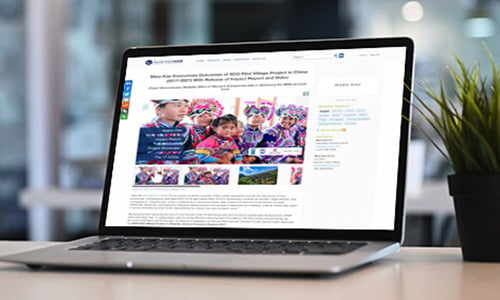Everyone wants to be featured in the New York Times. If it's not the New York Times, Wall Street Journal, Bloomberg, or the Associated Press—or an interview on CNBC—it's common for corporate leadership to ask, "Why bother?"
There is no doubt that mainstream publications deliver the widest, largest audience possible. However, it's also the broadest and most general. From a resource perspective, the time spent preparing for and engaging in an interview with a mainstream outlet—versus the number of readers or viewers that that news organization delivers—seems, on the surface, to be the most efficient use of that executive's time.
Unfortunately, this perspective on the quality of media coverage is too narrow a view and often holds companies back from speaking more directly to their target market and gaining the attention of mainstream reporters. In a world of Google searches, Apple News, and LinkedIn feeds, mainstream reporters constantly use these tools to hunt for even the smallest emerging trends that could be the seed of their next story. And, with these feeds, one article in an obscure blog post with the right keywords can surface at the top of a smartphone app. For these and other reasons, coverage in smaller trade outlets matters just as much as securing that coveted Wall Street Journal piece.
Looking more closely, coverage in trade publications and smaller-audience outlets, including newsletters and podcasts, can provide value on multiple levels:
1. Support for Mainstream Reporters
Trade mentions help mainstream reporters "do their homework" by revealing trends and companies to watch out for. These articles signal to the generalist writer that someone who deeply understands that technology or market felt that the news was valid and worth their time to cover. If the trade writer stakes their reputation on the topic, it lends credibility to the subject and gives the mainstream reporter more confidence to follow the idea. This also helps the reporter pitch the concept to their editors, who are often the pickiest people to win over at an outlet.
In this way, trade stories validate a company's story for mainstream reporters—thereby accelerating the possibility of a future potential story in a mainstream publication.
2. Training Ground for Bigger Stories
Another hidden benefit of seeking trade media opportunities is that these interviews can serve as a training ground for company executives.
Trade reporters are typically not writing under pressure or strict deadlines. This means they have more time and interest in doing interviews. Company spokespeople can take their time to build a rapport with these trusted industry insiders and hone their storytelling skills and sound bites with these friendlier outlets. As executives get more comfortable answering media questions, they become better prepared for future interviews with time-crunched, mainstream reporters.
3. A Push from Google News and Search
Many trade publications are Google News partners. Google News aggregates content from more than 20,000 publishers, and each month, Google News and Google Search link people to publishers' websites more than 24 billion times.
When news gathering organizations of any size publish to the Internet, those links can appear alongside mainstream outlets. With a compelling enough headline, thumbnail photo, or meta description, readers may choose articles from trade publications over those from more well-known outlets.
4. More Influential than Mainstream to Target Customers
When doing their due diligence or research before making a purchase, prospective customers often read trade press mentions as part of their awareness and buyer's journey for a particular solution. In fact, overlooking media opportunities with trade publications could mean a decline in sales for the company.
Industry players, customers, and investors tend to trust trade reporters more than they would a mainstream reporter, for the same reasons mainstream reporters use trade articles as fodder for their ideas. Journalists at trade publications deeply understand the tech and trends of their industry and are a good signal that the story is worthy of other's time.
“Smart communications leaders aim to deliver the right message to the right audience from the right source,” says Scott Clavenna, CEO of Latitude Media. “It's that third piece of the puzzle — having the message amplified by a trustworthy, insider source — that helps brands build credibility in a meaningful way.”
Neglecting the time to respond to inquiries or participate in interviews with trade publications can cause the company to lose out on untold opportunities. Worse, it can put the company's reputation at risk.
Companies can discover strong value in pursuing opportunities with trade media. While the immediate ROI might not be obvious, establishing and maintaining relationships with reporters from media outlets of all levels of influence can yield innumerable benefits in the long run. As we like to say, let 1,000 headlines run.

From the newsroom to the boardroom, Lisa Ann has used her keen analytical skills to share technology stories with the world for over a decade. She is founder and CEO of the award-winning Technica Communications, founder and Chairwoman of the non-profit Women In Cleantech & Sustainability, host of the podcast Earthlings 2.0, an international speaker and moderator, and documentary filmmaker. Her work has been broadcast on National Public Radio, PBS Television, WPXI-NBC, American Public Media, The Environment Report, Great Lakes Radio Consortium, Free Speech TV, WYEP 91.3FM-Pittsburgh, WRCT 88.3FM-Pittsburgh, and WCPN/WVIZ PBS ideastream in Cleveland.
Learn more
Learn more about distributing your news with Business Wire, including trade media
Business Wire’s trade media list
View Business Wire press release examples
Get the latest PR, IR, Marketing and Media tips on the Business Wire Blog. Subscribe today!





